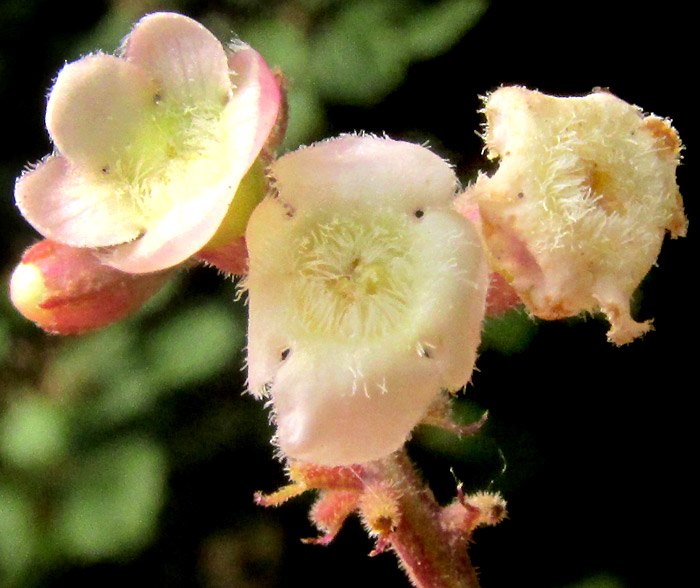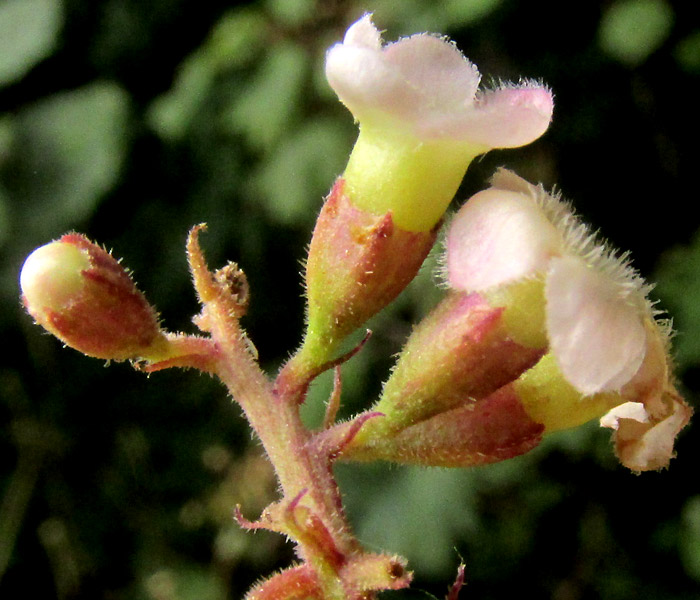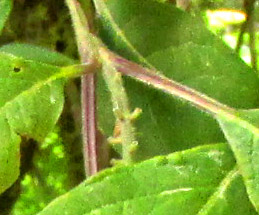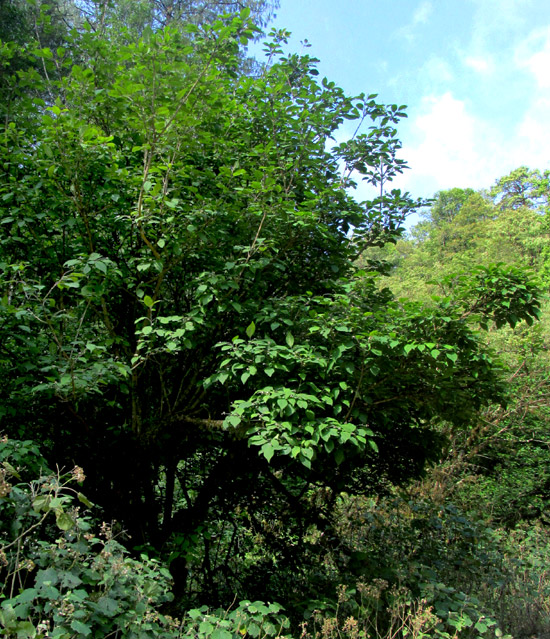Excerpts from Jim Conrad's
Naturalist Newsletter
Entry dated April 21, 2024, from notes taken about 1.5km north of La Cañada, on small branch road off Hwy. 120, Municipality of Pinal de Amoles; N21.127°, W99.661°, elevation ~2460 meters (~8070 feet); oak-pine on limestone bedrock; in the Eastern Sierra Madre Mountains of east-central Querétaro state, MÉXICO
FIDDLEWOOD TREE

A stone-toss from a dry streambed in the bottom of a valley mostly vegetated with deciduous bushes and trees, the above was a low branch on a tree about 10 meters tall (~30ft). Impressed veins on the leaves' upper surfaces wrinkled the blades, and a few white flowers clustered at the tips of long, slender, dangling, raceme-type inflorescences.

Some flowers developed four corolla lobes, while most appeared to have five. Long, soft hairs at the corollas' mouths nearly blocked entry into young corollas, but on older flowers the hairs were directed upward, opening the mouths.

A side view of the flowers shows that the white corolla lobes stood atop substantial, yellow corolla tubes. The tubes arose within pinkish-green calyxes which didn't produce regular sepals, but rather along their rims bore short teeth. A slender, sharped-tipped, scale-like bracteole arose at the base of each short flower stalk, or pedicel. Calyxes, pedicels and stems were all suffused with pinkness, and short hairs.

The above details, especially the long, slender racemes with flowers only at their tips, didn't help much in the tree's identification. I was in the dark until noticing the good field mark seen at the right: The purplish stem spanning the picture from top to bottom is strongly angular in cross-section. That's typical of just a handful of plant families, mainly the Mint Family, the Lamiaceae, but also often the Vervain or Verbena Family, and appearing less commonly in several other families.

At the left, our tree's trunk branched from the base, as if a mother tree had been cut, and the current stems sprouted from the stump. In the shady, humid stream bottom, the trunks were heavily covered with mosses.

At the right, our tree emerges amid other kinds of trees, bushes and weeds.
Although I've seen tree members of the overwhelmingly herbaceous Mint Family, such as Teak Trees, our plant's flowers weren't bilaterally symmetrical like most Mint Family flowers. Therefore, to find our tree's identity, first the Vervain or Verbena Family, the Verbenaceae, was looked into.
In our region of upland central Mexico known as the Bajío, if you have a tree member belonging to the big Verbena Family, the flowers are arranged in raceme-type inflorescences, flower calyxes are cup-like with only small teeth along the upper rims, and leaf margins lack teeth or lobes (they're entire), you have a member of the genus Citharexylum. Species of Citharexylum often are referred to as fiddlewoods or zitherwoods; and it's true that fiddlewood wood has been long used in the construction of musical instruments. The genus name Citharexylum is from the Greek kithara, meaning lyre or fiddle, and xylon, meaning wood.
Also in our region, if you have a Citharexyum whose raceme-type inflorescence is quite long and slender, the leaves are not thick and leathery, and the stems are conspicuously squared in cross-section, not just vaguely so, you have CITHAREXYLUM AFFINE, whose features match our plant's perfectly.
Even though at first I didn't recognize this tree as a fiddlewood, I've encountered other Citharexylum species, also here in Querétaro state. There was a fruiting Citharexylum berlandieri, but its cluster of fruits was very short, almost spherical. Also there was a flowering Citharexylum lycioides, whose blossoms were similar to our tree's, but were arranged in small clusters in leaf axils. This fiddlewood genus is just good at producing different-looking species on the fiddlewood theme.
Citharexylum affine, with no English name for itself other than the general "fiddlewood," occurs in humid places mainly in oak forests in the highlands from Sinaloa state in Mexico's Western Sierra Madres, south throughout Mexico into Guatemala. In our region the Flora del Bajío regards the species as rather rare -- "... más bien rara."
Most pictures of the species show slender racemes bearing white flowers throughout their entire lengths. Flowers on our tree's racemes appear to have aborted not long after opening, leaving behind nothing but short, fruitless stubs, with their bracteoles. I'm guessing that this can be explained by the fact that the North American Drought Monitor currently maps this area's continuing weather pattern as a D4 Drought, the Monitor's droughtiest rating, beyond D2 Severe and D3 Extreme. Possibly also relevant is that here I see much fewer pollinators than expected.
As I was photographing our tree an old fellow on his way to feed his cattle upslope told me that the tree produced small fruits called pasillas, that word apparently derived from pasas, for "raisins." Lots of species of many kinds and their raisin-size fruits are called pasillas. "But the pasillas aren't for people because they're too small with too much seed and too little flesh; they're for animals," he said. Beyond our region, the tree has several local names, including chachalaca and chachalacámetl, referring to the pheasant-like chachalaca bird, easily imagined gorging on these fruits. Despite the old man's opinion, the 2022 study by Pablo Moroni and others entitled "Las Verbenáceas Comestibles de América: Una Revisión Bibliográfica, lists the fruits as edible.